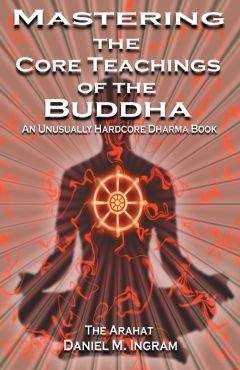Daniel Ingram - Mastering the Core Teachings of Buddha - An Unusually Hardcore Dharma Book
На электронном книжном портале my-library.info можно читать бесплатно книги онлайн без регистрации, в том числе Daniel Ingram - Mastering the Core Teachings of Buddha - An Unusually Hardcore Dharma Book. Жанр: Прочее издательство -, год 2004. В онлайн доступе вы получите полную версию книги с кратким содержанием для ознакомления, сможете читать аннотацию к книге (предисловие), увидеть рецензии тех, кто произведение уже прочитал и их экспертное мнение о прочитанном.
Кроме того, в библиотеке онлайн my-library.info вы найдете много новинок, которые заслуживают вашего внимания.

Daniel Ingram - Mastering the Core Teachings of Buddha - An Unusually Hardcore Dharma Book краткое содержание
Mastering the Core Teachings of Buddha - An Unusually Hardcore Dharma Book читать онлайн бесплатно
strange breathing patterns increasing in speed, and then finally half way down an out-breath there is a shift, things drop down slowly, it takes work to stay with things as they slow down, and then things bottom out.
The breath may stop entirely for a while. Then things come back up with the breath, attention tends to flag, things relax, and then the cycle begins again with things speeding up, etc. These breathing cycles may happen quite on their own and may even be difficult to stop when we are deeply into this stage. Those using visualizations as object, may notice that the objects begin to spin with the phase of the breath, or move in ways that they seem to have a life of their own, albeit a two dimensional one, as compared to the three dimensional visions that may arise later.
As this stage deepens and matures, meditators let go of even the high levels of clarity and the other strong factors of meditation, perceive even these to arise and pass as just vibrations, not satisfy, and not be self.
They may plunge down into the very depths of the mind as though plunging deep underwater to where they can perceive individual frames of reality arise and pass with breathtaking clarity as though in slow 177
The Progress of Insight
motion. It can even feel as if we have been submerged in thick syrup and partially sedated with some strong, opiate-like drug.
At the bottom of these depths, however they present themselves, individual moments may sometimes have a frozen quality to them, as if sensations were stopping completely in the middle of their manifestation for just an instant, and this way of experiencing reality is unique to this stage. Somewhere in here is the entrance to the third vipassana jhana in U Pandita's model, though there is some controversy about exactly which insights line up with which vipassana jhanas from here on out. I prefer to think of the Arising and Passing Away being purely second vipassana jhana. I will discuss these controversies in the following chapter.
They may be able to meditate with profound clarity even when asleep, and the need for sleep may be greatly reduced. Wild “kundalini”
phenomena are very common at this point, including powerful physical shaking and releases, explosions of consciousness like a fireworks display or a tornado, visions, and especially vortexes of powerful fine
“electrical” vibrations blasting down one's spinal column and/or between one's ears. These vortexes can be very loud. These sorts of experiences can occur quite unexpectedly and even off the cushion, such as in lucid dreams. They may be followed by various mixtures of wonder,
excitement, bliss, extraordinary joy, and sometimes disorientation. It is not uncommon for those in the height of the rapture of this stage to associate some of these occurrences with those of an extended orgasm.
None of these things are a problem unless their true nature is not understood or unless they happen when one is doing something like driving a car down an interstate at 75 miles per hour (a story for another time).
Strong sensual or sexual feelings and dreams are common at this stage, and these may have a non-discriminating quality that those attached to their notion of themselves as being something other than partially bisexual may find disturbing. Further, if you have unresolved issues around sexuality, which we basically all have, you may encounter aspects of them during this stage. This stage, its afterglow, and the almost withdrawal-like crash that can follow seem to increase the temptation to indulge in all manner of hedonistic delights, particularly 178
The Progress of Insight
substances and sex. As the bliss wears off, we may find ourselves feeling very hungry or lustful, craving chocolate, wanting to go out and party, or something like that. If we have addictions that we have been fighting, some extra vigilance near the end of this stage might be helpful.
This stage also tends to give people more of an extroverted, zealous or visionary quality, and they may have all sorts of energy to pour into somewhat idealistic or grand projects and schemes. At the far extreme of what can happen, this stage can imbue one with the powerful charisma of the radical religious leader.
Finally, at nearly the peak of the possible resolution of the mind, they cross something called “The Arising and Passing Event” (A&P
Event) or “Deep Insight into the Arising and Passing Away.” This event marks a profound shift in the meditator’s practice, and from then on they will be somewhat changed by what they have seen, with this being the Point of No Return that I mentioned in the Foreword and Warning.
The intensity of this event can vary, though it tends to be quite clear and memorable, particularly the first time one crosses it during that cycle.
It should also be noted that some people will have a big and obvious buildup to such experiences and for others they will suddenly just show up completely without warning, sometimes spontaneously and even without formal meditation training, as happened to me at around age 15. I have a number of friends who ran into these things without formal training and in daily life, others who ran into them when doing hallucinogens including mescaline and LSD, others during yoga practice, others while around powerful spiritual figures, including one who had it happen while hanging out with a Christian faith healer and a few who were hanging out with various gurus.
Whatever context the first A&P Event happens in, that context will tend to hold a special place in that person's heart from then on. For me it happened on my own, by my own meditation efforts and without a tradition, and so I have always associated my own practice with progress.
My friend who had it happen with the Christian faith healer became the most hardcore Christian you could find. Another friend who had it happen while on mescaline has since held a special place in her heart for shamanism. Those who had it happen with gurus tended to follow those gurus for some period of time, associating it with the gurus 179
The Progress of Insight
presence. Some others who had it happen in an apparently random context usually had no idea what it was or what it had done to them, but most have realized that something was different and nearly all remember it with an uncanny clarity as somehow standing out from ordinary experiences.
Once one has attained this event, it is fairly likely that one will be able to attain the first stage of awakening sooner or later if one can navigate the Dark Night skillfully (read: simply keep practicing). Thus, a good first goal in insight meditation is to cross the A&P Event at one’s earliest possible convenience, with caveats given later in the section on the Dark Night.
The A&P Event can happen in three basic ways corresponding to the Three Characteristics, just as can the entrance to insight stage 15.
Fruition, and the two are easily confused for this and other reasons.
There is great variation in the specifics of what we are seeing and feeling when we cross this profound and intense event, but certain aspects of these events will be common to all practitioners. This event tends to manifest in a way that can mirror the Three Doors (described in a few chapters) at about the middle of the out breath, leading to an unknowing event, followed by a few exceedingly clearer and more distinct moments imparting some deep understanding of the Three Characteristics before a second unknowing event at the end of the breath. It is not uncommon for the A&P event to occur during a particularly lucid dream or at least in the middle of the night.
Now, it should be noted here that it is unlikely in these extreme moments for the sense of the breath to be particularly clear, but this is how things happen regardless. In these moments, most, but not all, of their sensate universe strobes in and out of reality, arises and passes.
The subtle background and sense of an observer still seems to stay stable. In contrast to this, the entrance to stage 15. Fruition is through one of the Three Doors, involves the complete sensate universe (background, time, space and all), happens at the end of the out breath, and does not involve two closely related unknowing events. (The usefulness of this information may become apparent later on.) Those who have crossed the A&P Event have stood on the ragged edge of reality and the mind for just an instant, and they know that 180
The Progress of Insight
awakening is possible. They will have great faith, may want to tell everyone to practice, and are generally evangelical for a while. They will have an increased ability to understand the teachings due to their direct and non-conceptual experience of the Three Characteristics.
Philosophy that deals with the fundamental paradoxes of duality will be less problematic for them in some way, and they may find this fascinating for a time. Those with a strong philosophical bent will find that they can now philosophize rings around those who have not attained to this stage of insight.
They may also incorrectly think that they are enlightened, as what they have seen was completely spectacular and profound. In fact, this is strangely common for some period of time, and thus may stop
practicing when they have actually only really begun.
This is a common time for people to write inspired dharma books, poetry, spiritual songs, and that sort of thing. This is also the stage when people are more likely to join monasteries or go on great spiritual quests. It is also worth noting that this stage can look an awful lot like a manic episode as defined in the DSM-IV (the current diagnostic manual of psychiatry). The rapture and intensity of this stage can be basically off the scale, the absolute peak on the path of insight, but it doesn’t last.
Soon the meditator will learn what is meant by the phrase, “Better not to begin. Once begin, better to finish!” as they are now too far into this to ever really go back. Until they complete this progress of insight, they are “on the ride” and may begin to feel that the dharma is now doing them rather than the other way around, as they will progress inevitably and relatively quickly, usually within days, into stages 5-10, which as you will shortly see, are not always a party. The rapture and all the bells and whistles die down quickly, and the meditator may even be left raw as if hung over after a night of wild partying. The clarity fades somewhat, and the endings of objects becomes predominant as they progress to knowledge of...
5. DISSOLUTION, ENTRANCE TO THE DARK NIGHT
Thus begins what are called the “Knowledges of Suffering” or “The Dark Night of the Soul” (to use St. John of the Cross’ terminology). I consider this the entrance to the third vipassana jhana, though U
Pandita considers this the entrance to the fourth vipassana jhana. I'll give 181
The Progress of Insight
my arguments for this later in the chapter that deals more directly with the vipassana jhanas.
The Dark Night spans stages 5 through 10 in this map, namely Dissolution, Fear, Misery, Disgust, Desire for Deliverance, and Re-observation. Stages 5 through 9 tend to “come as a package,” with one leading fairly quickly and naturally to the others. Stage 10, Re-observation, tends to stand out as its own distinct and often formidable entity. It should be noted that some pass through the Dark Night quickly and some slowly. Some barely notice it, and for some it is a huge deal, regardless of the speed at which one moves through these stages. Some may get run over by it on one retreat, fall back, and then pass through it with no great difficulties some time later. Others may struggle for years to learn its lessons.
I am going to describe the Dark Night largely in extreme terms, but realize that this is just to give a heads up to what is possible, not what is necessary or guaranteed. As before, on retreat these things are likely to be more intense and clear, though those on retreat who are able to keep practicing are likely to make much faster progress as well. On the other hand, practice in “daily life” can be powerful and sometimes very speedy. These things are strangely unpredictable. Enough disclaimers!
Once someone has crossed the Arising and Passing Event, one will enter the Dark Night regardless of whether one wants to or not. It doesn’t matter if you practice from this point on; once you cross the A&P you are in the Dark Night to some degree (i.e. are a Dark Night Yogi) until you figure out how to get through it, and if you do get through it without getting to the first stage of enlightenment, you will have to go through it again and again until you do. I mean this in the most absolute terms.
The Dark Night typically begins with just about all of the profound clarity, mindfulness, concentration, focus, equanimity and bliss of the previous stage dropping away. So also ends the cause-and-effect-like phenomena of the breath or walking shaking or jerking up and down in a way related to attention and noting, as well as all of the fine vibrations and vortex-like raptures. Early on, the frequency of vibrations disconnects from the cycle of the breath, remaining largely stable at 182
The Progress of Insight
whatever frequency is going on at that stage once they can be perceived again (in late Dissolution or Fear).
Whereas one might have felt that one’s attention had finally attained the one-pointed focus that is so highly valued in most ideals of meditation during the Arising and Passing Away, during the Dark Night one will have to deal with the fact that one’s attention is actually quite wide and its contents unstable. Further, the center of one’s attention becomes the very least clear area of experience, and the periphery becomes predominant. This is normal and even expected by those who know this territory. However, most meditators are not expecting this at all and so get blindsided and wage a futile battle to make their attention do something that, in this part of the path, it simply won’t do.
If one has ever been meditating in a place with lots of mosquitoes buzzing in one’s ears in a way that made it very hard to concentrate on the primary object, one can get a sense of what one’s attention will be like in the Dark Night. Rather than fighting against this and ignoring the metaphorical mosquitoes, one should try to understand what it feels like to have one’s attention be however it is. Just like listening to discordant, chromatic jazz with lots of jarring harmonies and instruments playing more at odds with each other than together takes some getting used to, the quality of attention in the Dark Night is an acquired taste, and the sensations that arise tend to be very rich, complex, broad and unsettling.
Those that fixate on staying one-pointed will suffer more than those who learn to stay with what is going on regardless of whether or not it feels like “good meditation.”
In that same vein, those who are using some other object as a focus will notice the same phenomena of the width of attention being wider and the basic sense that attention seems to sort of be out of phase with phenomena. Those doing visualizations may notice that they see a black spot in the center of their attention with some sort of patterns or visions around the edge of it spreading wider and wider out into the periphery.
Those using a mantra may feel that the mantra is out of phase with attention, wide and complex and yet hard to stay with, and may acquire more complex harmonics and harmonies if it is in any way musical, like listening to a large, ghost chorus that is off to the sides of you, whereas before the mantra may have felt centered in the stereo field of attention.
Похожие книги на "Mastering the Core Teachings of Buddha - An Unusually Hardcore Dharma Book", Daniel Ingram
Daniel Ingram читать все книги автора по порядку
Daniel Ingram - все книги автора в одном месте читать по порядку полные версии на сайте онлайн библиотеки My-Library.Info.




